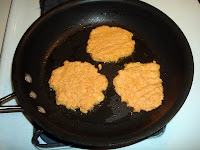all the uses for the versatile sweet potato
as well as how I might grow, store and prepare
them if I added a small crop to my garden.
It is one of my favorite veggies and satisfies
my sweet tooth too. I was particularly
interested in how one makes sweet potato flour,
so I did some googling on that and came up with
this cool site. "Dang!", I thought to myself,
"these taters deserve their own thread". :
_____________________________________________________
 HOW THE FARMER CAN SAVE HIS SWEET POTATOES
HOW THE FARMER CAN SAVE HIS SWEET POTATOES
AND WAYS OF PREPARING THEM FOR THE TABLE BY GEO. W. CARVER, M. S. AGR., D. Sc.
Director, Experiment Station, TUSKEGEE INSTITUTE
Tuskegee Institute Press 1937
http://plantanswers.tamu.edu/recipes/sweetpotatoes.htmlHere's a nibble from this page:
HOW TO MAKE SWEET POTATO FLOUR
There are several grades of this product and quite as many ways to manufacture them. Each one of these flours or meals (as most millers insist upon calling them) has a particular character of its own and is therefore, adapted to certain uses the other products are not.
These sweet potato flours are generally speaking of three kinds.
First: Those made from the uncooked potato.
Second: Those made from the cooked potato.
Third: Those made from a careful system of roasting, or from the starch making process. The first two will interest the housewife most so, therefore, I will dwell almost or quite exclusively on these.
FLOUR No. 1. FROM THE RAW POTATO
Here, all that is necessary is to wash, peel and slice the potatoes real thin, dry in the sun, oven or dryer until the pieces are quite brittle, grind very fine in a clean coffee mill, spice mill, or any type of mill that will make wheat flour or corn meal; bolt through fine cloth in the same way as for other flours.
The fine flour-like particles will pass through and the coarse granular meal left on the bolting cloths.
USES
This kind of flour is fine for making mock rye bread, ginger snaps, wafers, waffles, battercakes, custards, pies, etc. Bread can be made with it, but it makes a dough deficient in elasticity, bread dark in color and a loaf which dries out quickly.
The coarser meals can be cooked in a. great variety of ways and make very palatable dishes, they Are to be soaked in warm liquid (whatever is desired. to cook them in) when soft, proceed as for grated potatoes.
FLOUR No. 2. FROM COOKED POTATOES
For the making of this flour the potatoes are broiled, or steamed (preferably the latter) until done, sliced or granulated by mashing or running through a food chopper and dried until they become very brittle, they are made into flour and meal exactly the same as given for Flour No. 1.
USES
This kind of flour is especially fine for bread, cakes, pies, puddings, sauce, gravies, custards, etc.
Indeed, most people consider a loaf made in the proportion of one-third sweet potato flour to two-thirds wheat flour, superior in flavor and appearance to all wheat flour.
Many experiments have proven that either the mashed sweet potato or the sweet potato flour may be used in bread up to as high as 50%, but at this point it becomes decidedly potato-like in texture and flavor but not unplatable or unwholesome.
FLOUR No. 3. FROM PULP
The sugar and starch has been greatly reduced. This flour is made from the pulp after the starch has been removed, it is dried without cooking, ground and bolted exactly the same as recommended for the other flours.
When made into puddings, pies, blancmange, etc., the same as shredded cocoanut, it resembles it very much in taste and texture and is very palatable, and is a most welcome addition to the dietary.
It can also be used in the baking of bread and is especially valuable where people object to a loaf with the least bit of a sweet taste, also where they wish one with as little starch and sugar as possible.
__________________________________________________________

Sweet Potato Pancakes
can be made from fresh potatoes
or using sweet potato flour (or meal)
for a smooth texture.
You can also buy ready-made mixes.
They are great for breakfast, lunch,
dinner and dessert, easily combining
with all kinds of foods.
-------------------------------------

Here's one basic breakfast recipe, but
there are more variations on this theme than
can be listed here. This uses grated potatoes
for a more rustic texture (as seen in photos above):
4-6 servings
Time 20 minutes
Tools: grater or food processor
large bowl
wooden spoon
frying pan
spatula
Ingredients:
1 large or 2 medium sweet potatoes or yams, peeled or scrubbed
Chopped walnuts or pecans
3-4 T lemon or apple juice
1 t salt
4 eggs, beaten
1/3 c flour
oil
Grate the sweet potatoes.
Put everything except the oil in the bowl and mix well.
Heat 1-2 t of oil until very hot.
Put some pancake mix on the frying pan and use the spatula to pat it down, forming a thin pancake.
Fry until brown, flip, and repeat, adding more oil as necessary.
These should be served hot, with butter, sour cream, yogurt, apple sauce, or your favorite sweet potato topping.
Bon Appetit!
